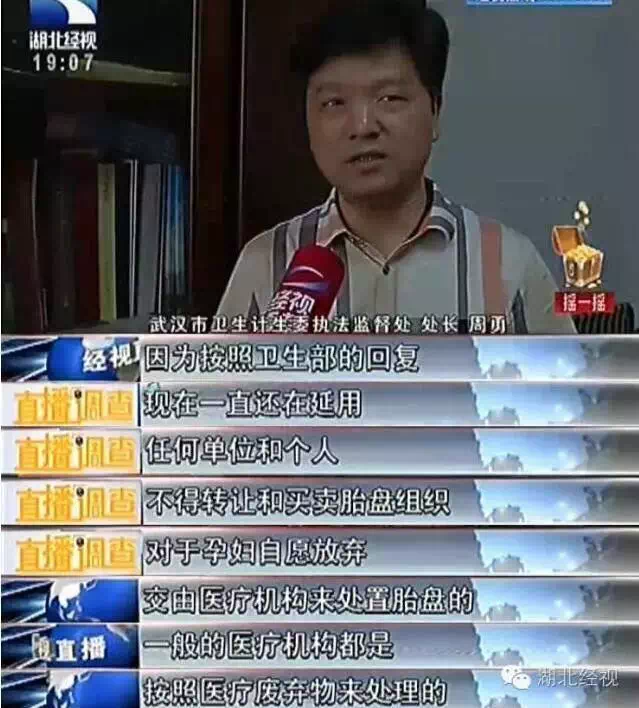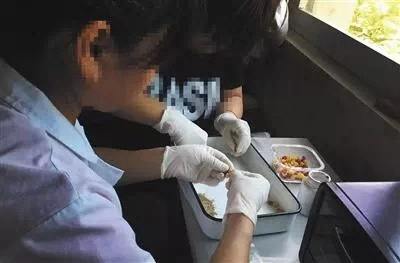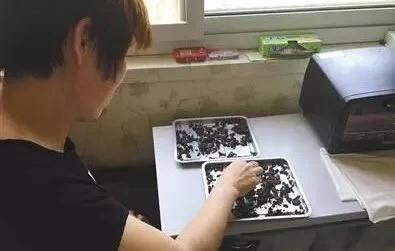First, the chaotic [placental market]
During pregnancy, a piece of nutrient built into the mother and fetus will automatically fall off and be discharged about 15-30 minutes after giving birth to the child, and become the [medical waste] to be treated for unified incineration, that is, placenta.
The picture is terrible. I use one sentence to describe it: a deflated balloon with blood stinging.
But it is this thing, this bloody human tissue, that is now linked to the placenta market, an extremely mature and profiteering industry.
Clove Garden once asked a director of obstetrics who had worked in many hospitals for many years and found that the price of buying placenta from hospitals was never high:
[I’ve heard of 10 yuan, 20 yuan, 35 yuan, and 50 yuan at the highest. I really don’t know how high it is.]
What is certain is that the transfer and sale of placenta are illegal:

However, when the purchase behavior moves up again, the price takes a roller coaster:
This thing, which claims to prolong life, beauty beauty and supplement various trace elements and active factors, has been dried by various hidden workshops, ground into powder and made into capsules…….
However, one kilogram of dry placenta can be sold for at least 1100 yuan, or it can be split into 100-120 pieces, each of which is about 10 yuan’s [placenta capsules].

The practice of the workshop is still a bit not modern enough, and the function that can make more money is beauty beauty.
So all kinds of human placenta and injections came out.
The price of 50 Japanese-made placenta injections is as high as 10,000 yuan in China-if calculated at 20 yuan per placenta, a pregnant woman can barely have enough placenta for one injection ten times, which shows how tight the demand for placenta is.
There are still many celebrities who have publicly used placenta. American socialite Kardashian made her son’s placenta into capsules and shared her experience of taking placenta pills in a high profile. The following are placenta capsules uploaded by Kardashian on social media:

[I feel the surge of energy in my body and feel really healthy and beautiful. I strongly recommend everyone to consider eating the placenta.]
There are also many stars in China. Big S once said in variety show < < Big and Small Love to Eat > >:
[The placenta of my elder sister’s first child has promised to be left to me, and the placenta of my elder sister and my younger sister are both stored for me.]
The BBC even summarized all kinds of placenta cuisine in the first program:
Fresh placenta with milkshake made of red plum
Dry to make capsules and eat them several times a day.
Make tincture and take it with water.
Cook as a substitute for beef, such as stir-fried dishes, hamburgers, stews or pasta with meat sauce.
After all, [this bloody human tissue] has the magic of what, and so many people can be found on its platform. Is this medical waste that automatically strips off the mother really so useful?
Second, [placenta] is nothing special
In fact, the behavior of “eating placenta” appears in the animal kingdom on a large scale.
Some studies believe that this is an energy supplement behavior that animals are too weak after giving birth. Some studies also believe that this is just an animal trying to hide the smell of this [bloody raw meat] so as not to be attacked…….

However, human beings have kept the placenta at a respectful distance from each other since ancient times.
Placenta recorded in ancient books in China is mostly buried and will not be used as food.
A number of medical books unearthed from Mawangdui Han Tomb show that placenta was buried and delivered as early as Qin and Han Dynasties, and it is clearly pointed out that this is for praying: after all, eating a piece of [human tissue] is still against human relations.
In particular, the placenta is really nothing special in terms of the nutrient elements that are most often mentioned in the placenta:
Statement 1: Placenta is rich in nutrients?
The placenta is indeed rich in protein, sugar, vitamins and minerals, but these are not great:
Modern people have almost exceeded the standard of protein and sugar intake, and if vitamins and minerals are really needed, they can be obtained with better diet collocation or even compliant and qualified drugs.

Statement 2: Placenta can enrich blood and relieve postpartum depression?
Placenta is rich in iron. It should be admitted that it does have the effect of improving anemia.
There are also views that placenta can increase the iron content of the mother by providing biological sources of iron, thus maintaining energy, resisting fatigue and relieving postpartum depression.
There is indeed a lot of heme iron in the placenta full of blood vessels, but this is nothing special:
Animal red meat, liver and blood are also available, and are safer, more hygienic, easier to obtain and taste better.
If it is suffering from iron deficiency anemia, it is obviously more acceptable to supplement iron with medically evidence-based treatment methods.
Statement 3: Eating placenta is beneficial to postpartum recovery?
Some people think that because the placenta is rich in [active factors] and some hormones (mainly oxytocin, thyrotropin releasing hormone, etc.), it is beneficial to postpartum recovery for parturients to eat after delivery.
However, the presence of these ingredients in the placenta does not mean that direct consumption can cure diseases.
Some substances have very little content, some substances are destroyed after high temperature, drying and other treatments, and some substances lose their activity through digestive tract decomposition.
In other words, even if these ingredients are really useful, they will disappear long before they are eaten in the stomach.
In addition, the body itself can maintain the balance of hormone levels, and people do not need to supplement them.
III. Placenta: Uncontrollable [Health and Safety] Problems
Even in traditional Chinese medicine, there has always been a placenta-derived medicinal material, Hominis Hominis, whose functions in traditional Chinese medicine books are warming kidney, invigorating essence, invigorating qi and nourishing blood. It was also removed from the list in 2015 by the Chinese Pharmacopoeia.
The reason is probably similar to what I want to say below:
[The health and safety of Hominis placenta cannot be controlled, especially the homemade Hominis placenta will bring serious health risks].
How uncontrollable [health and safety] problems will be specifically arrested and expelled from school?
1. The first is bacteria:
In addition to cesarean section, the separation of placenta and mother must pass through the birth canal, which contains a variety of bacteria.
Blood, as a good medium for bacteria, appears in large quantities in the placenta. There are not many others and there are enough blood vessels-think of the shriveled balloon with bloodstinging hula.
Besides, improper storage of placenta after delivery is easy to breed bacteria and even rot.
Reporters have [visited] these numerous black workshops before. They often open in residential buildings near hospitals. The general step is to dry the placenta directly, then grind it into powder and package it for sale.

However, a food to be imported has not been strictly disinfected and sterilized by what after passing through the birth canal. It is conceivable how susceptible it will be to diseases.
2. In addition to bacteria, there are maternal bacteria, i.e. Bacteria carried by the mother:
In order to maintain [activity], some people will choose to eat the placenta raw or only freeze-dry it.
Enthusiasm and seriousness about food materials are the fine traditions of Chinese gourmets, so the placenta on the tip of the tongue is no exception.
In order to maintain the original flavor of the placenta and ensure the taste of the placenta Q-bomb, there are also [raw pie] in the Jianghu-
The placenta that has just emerged from the belly is not a problem either. It can also go through the process:
Stir-fry, fry, stew, cook soup, braise in soy sauce……
Behind these joys is the dark attack on the placenta-
If the mother is infected, pathogens such as measles, hepatitis B, AIDS, syphilis and the like can also enter the placenta, thus bringing no small potential safety hazard.
If the placenta is obtained through private reselling, the safety is even more difficult to guarantee.
3. Possibility of excessive heavy metals:
Some researchers believe that, unlike other animals, the reason why people are born not to eat placenta may be that the use of fire has increased smoke and dust in the air during evolution. Long-term exposure of pregnant women to this environment may turn the placenta into a toxic organ with excessive heavy metals.
In < > (Women’s Mental Health Records), scholars from Northwestern University analyzed the results of 10 placenta-related studies since 1950 and found that there was no data to prove that placenta was beneficial to health.
In other words, the claim that eating placenta is beneficial has never been scientifically confirmed, while the safety risks of eating placenta are real.
